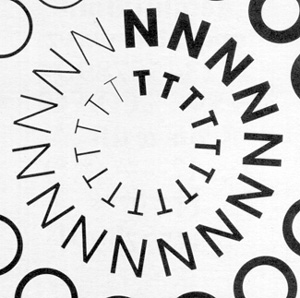dot-font: Avant Garde, Then and Now

dot-font was a collection of short articles written by editor and typographer John D. Barry (the former editor and publisher of the typographic journal U&lc) for CreativePro. If you’d like to read more from this series, click here.
Eventually, John gathered a selection of these articles into two books, dot-font: Talking About Design and dot-font: Talking About Fonts, which are available free to download here. You can find more from John at his website, https://johndberry.com.
As I was rummaging through back issues of “Upper & lowercase,” researching images and ideas for a forthcoming book on “U&lc” (coming next year from Mark Batty, Publisher, I came across an ad in the 20th-anniversary issue (Vol. 20, No. 1; Spring, 1993) that caught my eye. It was a two-page spread announcing that, on May 17, 1993, ITC Avant Garde would be available in Adobe’s new multiple master font format.
That date is almost exactly 10 years ago. Looking back on it a decade later prompts all kinds of reflections about the interplay of typographic fashion and font technology. Both fashion and technology change quickly; it would be hard to say, in the digital world, which one is more transient.
Yesterday’s Tomorrow
ITC Avant Garde already had a long history in graphic design, from its origins in the creatively explosive days of the late 1960s. The text of the 1993 “U&lc” ad is of course marketing copy, but it accurately places the typeface in its context: “Throughout its 25-year life, ITC Avant Garde has lived up to its name by continually breaking new ground. It began as Herb Lubalin’s logo for the always innovative, and often controversial magazine, “Avant Garde.” It then became the first typeface released by ITC when the company was founded in 1970. Because of its large x-height, extensive set of alternative and ligatured characters and strong design personality, the face also broke new stylistic ground for typeface creation. Now ITC Avant Garde is the first ITC typeface to be issued as a multiple master Type 1 typeface.” (See Figure 1.)

Figure 1: Multiple master technology could create almost infinite variations of a typeface.
Multiple master technology, which in the early ’90s was the Next Big Thing, is notoriously hard to explain in words and static images, but wonderfully easy to demonstrate by dragging a slider back and forth onscreen. As you drag the slider, the letterform you’re looking at morphs: from fat to thin, for instance, or from condensed to expanded, depending on how it was designed to change.
The slider is moving along the font’s “axis”; there’s a different version of the letter at each end of the axis (Extra Fat at one end, say, and Really Thin at the other), and as you drag the slider along the axis you can create any variation in between those two extremes. The technology behind this is more complicated (and the possibilities are really quite sophisticated), but it’s easy to see how it works in practice. The point is that the typeface designer creates those master designs at the ends of the axis, and determines just how the letter shapes will change as the slider is dragged. If the font has a width axis, then you can widen or narrow the letters without seeing the distortions in shape and stroke width that appear when you simply stretch or squeeze the type. The result is better-looking type (see Figure 2).
Figure 2: Multiple master technology gave designers unprecedented flexibility in adjusting the width, scale, and size of typefaces.
And a multiple master font can have up to three different axes, each of them changing the typeface in a different way. The multiple master version of ITC Avant Garde, for instance, had two axes: weight and width. So you could make everything from a very light, condensed version to a very heavy, expanded version—or, for that matter, from light and expanded to heavy and condensed.
The ad explained the potential uses of these options: “Now type in headlines and body copy can be exactly the proportions you want. Headlines can be customized subtly or dramatically in weight or width to precisely fit virtually any measure. Type in blocks of text copy can be adjusted subtly or dramatically to achieve just the color desired. Or type can be manipulated to compensate for the inherent differences in the appearance of type printed using various technologies, such as lithography, Xerography or gravure.” (See Figure 3.)

Figure 3: A detail of the 1993 ad in “U&lc” for the upcoming multiple master version of ITC Avant Garde.
Malleable Geometry
ITC Avant Garde was an odd choice for turning into a multiple master typeface. The original design was strictly geometric, based on large, perfectly round counters and curves, and short straight lines. Even creating a condensed version (which Ed Benguiat did in 1974) was a difficult enterprise; when the circle becomes a narrow oval, the whole character of the typeface changes. What would it be like if you could generate any degree of condensed or expanded letters that you wanted? Wouldn’t it look a little odd, if they were all mixed together?
ITC Avant Garde was a quintessentially 1970s typeface, created by Herb Lubalin and Tom Carnase for the kind of “expressive typography” practiced in the New York advertising world at the time. It was made for tight layouts and boldly conceived headlines. I can only speculate on what Lubalin would have thought of the infinite malleability of a multiple master typeface, or what he would have done with it. He might have been delighted, or he might have been appalled. He would certainly have used its possibilities in extremely creative ways.
One of the problems of ITC Avant Garde is that it takes a typographer of Lubalin’s skill to use it well. It’s extremely easy to use Avant Garde badly—all the more so if you try to emulate that 1970s style of composition. The multiple master version only gave us an even wider range of potential disaster.
The Tool Not Used
But only if people actually put it to use. I have no idea how well ITC Avant Garde multiple master sold, either then or later, but the multiple master technology never took off with the majority of type users. And that’s a shame. It had the potential to revolutionize how type got set, and to improve the quality of everyday type to an enormous degree. But it fell between the cracks of the software development process.
Multiple master became an esoteric technique for advanced type users (I’ve used multiple master typefaces extensively in books and other kinds of graphic design), but what it should have been was an intuitive tool for the masses. If every Adobe application had incorporated a simple interface for generating multiple master “instances,” and if popular business applications like Microsoft Word or Excel had been designed to automatically choose the appropriate font instance, then multiple master technology would have proliferated, seamlessly and invisibly—and the quality of everyday, ordinary typesetting would be a lot better than it is today.
But to have this happen would have required that the software development teams working on all these products, both within Adobe and in other companies, recognize the importance of this font technology. And, for the most part, they didn’t. Multiple master seemed superfluous, a specialist’s toy, rather than a core technology for manipulating type wherever it’s used.
So instead of incorporating an easy way to use multiple master fonts in each application, they forced users to “generate an instance”—one that was named with a ridiculous string of numbers and letters, which might describe it technically but meant nothing to anyone trying to use the font—and only then would that particular version of the typeface be available for use in the application. If the user wanted a slightly different version (more condensed, say, or a different optical size), they’d have to go generate that instance, too, before they could use it. This was a magnificently cumbersome way to work, and not surprisingly very few people bothered.
A Chance Missed
Today, multiple master technology is all but dead. A couple of years ago, Adobe stopped officially supporting it—which means, in effect, that there’s no guarantee that a multiple master font will work properly in new versions of Adobe applications. (Not to mention any other company’s programs.) Some of the subtleties of the better-designed multiple master typefaces (like optical sizes) have been carried over to the newer OpenType font format, but without the infinite variation that multiple master’s design axes made possible. The only place where the technology still appears is in Adobe Type Manager, which uses the multiple master fonts Adobe Serif and Adobe Sans to mimic the character widths of missing fonts in a document.
And ITC Avant Garde? It’s still in wide use, though perhaps not in its multiple master version. Indeed, over the last few years, it’s had a revival, thanks to the popularity of the Retro Seventies look in graphic design. It’s still hard to use well, but it still provides designers with another tool for creative typography.
This article was last modified on March 4, 2022
This article was first published on May 5, 2003




